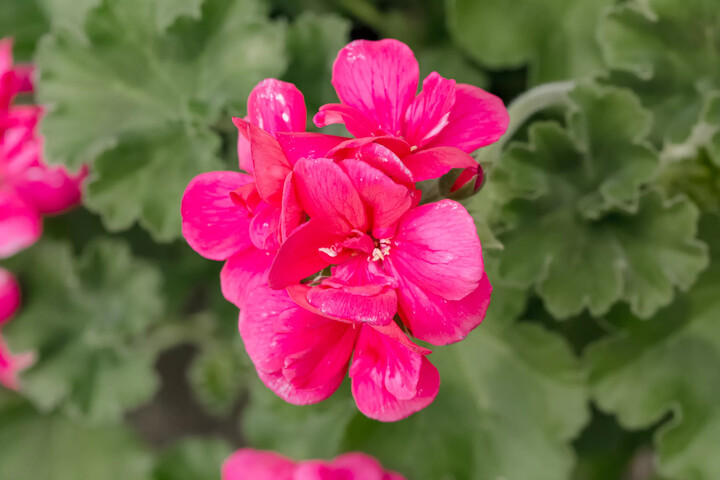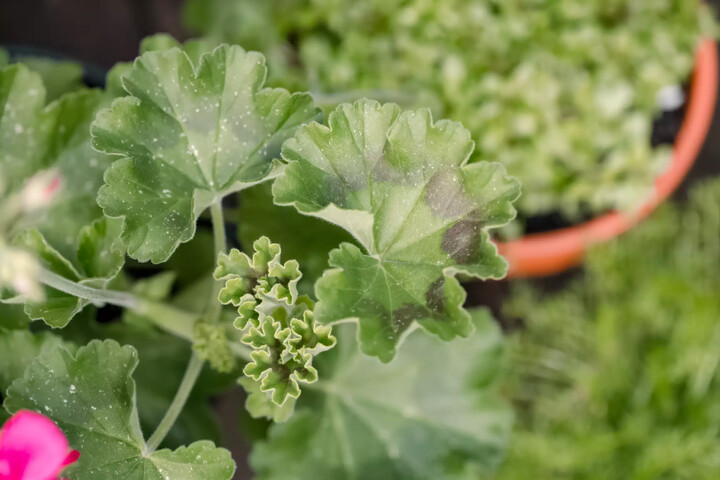No garden is complete without geraniums (Pelargonium), and they’re so easy to grow that no gardener should be caught without one. Geraniums can be grown right in the garden in zones 8–11 where winters are mild, but they bloom even better where they are slightly root-bound (tightly packed, such as in a container), as long as they have good drainage. When grown in pots, geraniums can also be relocated at a moment’s notice, whether to show them off near an entry, to bring them indoors during surprise freezes, or to move them to a shadier spot in the hottest days of summer.
Types of and Uses for Geraniums
These South African perennials are available in a multitude of species and hybrids, each with its own assets. Some, like the "zonal" geraniums, are grown for their variety of colorful flowers and velvety rounded leaves that feature bands of color arranged in zones, hence the name. Others, such as the handful of species known as scented geraniums, are beloved for the many different fragrances of their finely-cut leaves. Although the plant is not edible (and leaves must be removed before eating a dish they're cooked in), the leaves of rose, mint, chocolate, and lemon fragrant geraniums can be used to impart delicate flavors to sugars, preserves, and drinks, among other things.
Whatever species or hybrid you grow, all geraniums need protection from winter freezes, summer heat, and soggy soil caused by overwatering. As long as you follow a few simple tips, geraniums will be some of the easiest and most prolific flowers you’ll ever grow.

Provide Full Sun
Geraniums need lots of direct sun to bloom well, so let them soak up those rays by placing them on the south side of walls, on patio tabletops, or as an accent in sunny areas of the garden. If you notice that your plant has stopped blooming in summer, don’t panic. Geraniums have a tendency to stop blooming during hot weather, so just move your plant where it will receive some afternoon shade if you live in a hot climate.
Mind the Moisture
Although geraniums do require moisture, they will likely rot if the potting mix stays wet for too long. To prevent this, water only when the top inch of the potting mix is dry, and make sure that moisture can easily drain away through holes in the pot. Geraniums are relatively drought-tolerant and will survive a fair amount of neglect but should be watered before the roots are allowed to dry out completely.
Keep Geraniums Blooming
To keep geraniums in bloom, remove spent flower stalks periodically. To keep plants bushy, full, and packed with flowers, pinch out new growth occasionally by pruning the tips of each stem with sharp, clean shears. Geraniums bloom best when somewhat root-bound, so repot geraniums in larger containers only when necessary, and use a container only one size bigger than the previous one. Geraniums are heavy feeders, so fertilize in spring and summer with a balanced fertilizer, according to the product label's instructions. Stop feedings at the end of summer.
Protect From Freezes
Gardeners in zones 8–11 can get away with merely covering their geraniums up on frosty nights, but everyone else should overwinter them indoors. Bring your geraniums inside before the first hard frost and place them in a sunny window, or let them go dormant in a cool, dark place.
Keeping Them Healthy Indoors
Keeping geraniums in bloom indoors can add some cheer to a drab winter. The key is to maintain temperatures more than 50 degrees Fahrenheit, allow the soil’s top inch or two to dry out before watering, and keep an eye out for any diseases or pests.
Watch for Spider Mites
Watch overwintering geraniums for evidence of spider mites especially. You may see parched leaves, webbing, or tiny specks that resemble spiders when seen under a magnifying glass. Spider mites are best treated early—as soon as you spot the problem. First, segregate the affected geraniums from the rest of your plants and then treat them consistently and aggressively with a 1 percent solution of Neem oil spray. The product doesn't kill them immediately, as it's not a poison, but it does interfere with their biological systems. Soak both the plant and the top of the soil for best results.

Let the Plants Go Dormant
If you’re lacking in space or don’t have a sunny window, you can let your geraniums go dormant for the winter by placing them in a cool (below 70 degrees Fahrenheit) and dark space such as a garage or basement, as long as it doesn’t get below freezing. Then let the soil dry out so that it remains only barely moist. Remove leaves and flowers as they die off, and inspect the roots and crown occasionally for rotting parts. Remove rot with a sharp, sterilized knife.
After the last frost in spring, resume normal watering (when the top inch is dry) and begin placing your geranium outdoors each day. You will want to harden off (the technique of adjusting the plant to the outdoor spring temperatures) your plants for about a week, slowly moving them to sunnier positions so that the leaves can adapt to the extra sun without burning. After the plant is in position and weather no longer gets too cold for the plant (nighttime temps above 50 degrees Fahrenheit), you may begin feeding again.
That's it. Just water, feed, and keep them from freezing. You'll find that geraniums are some of the most carefree and rewarding flowers you’ve ever grown in a container garden—indoors or out.